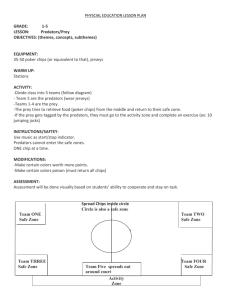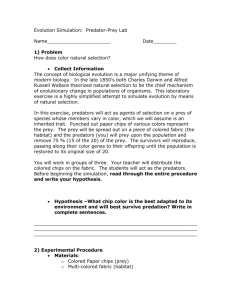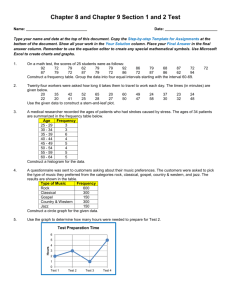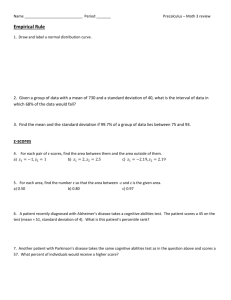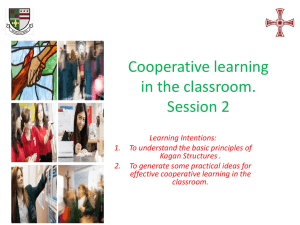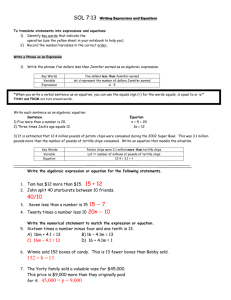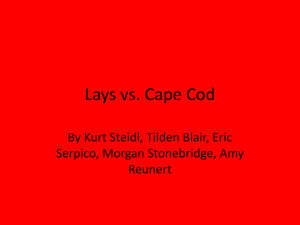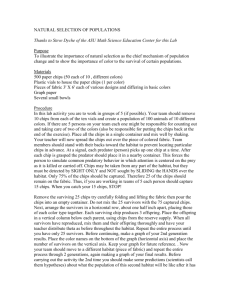Lesson Plan on Competition
advertisement
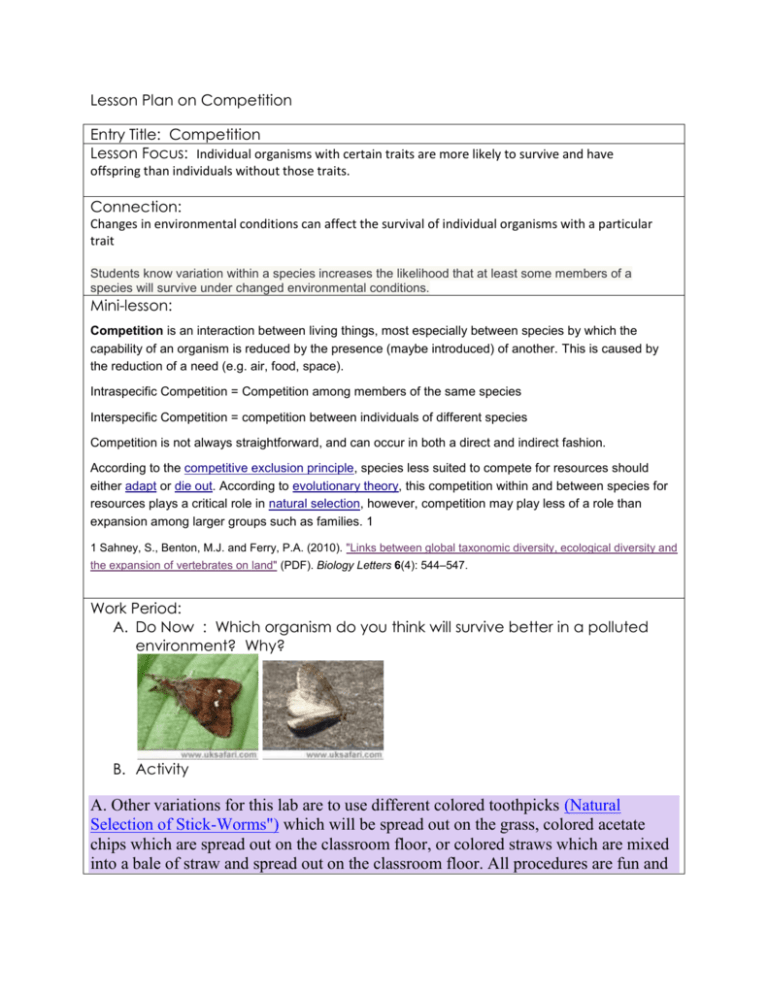
Lesson Plan on Competition Entry Title: Competition Lesson Focus: Individual organisms with certain traits are more likely to survive and have offspring than individuals without those traits. Connection: Changes in environmental conditions can affect the survival of individual organisms with a particular trait Students know variation within a species increases the likelihood that at least some members of a species will survive under changed environmental conditions. Mini-lesson: Competition is an interaction between living things, most especially between species by which the capability of an organism is reduced by the presence (maybe introduced) of another. This is caused by the reduction of a need (e.g. air, food, space). Intraspecific Competition = Competition among members of the same species Interspecific Competition = competition between individuals of different species Competition is not always straightforward, and can occur in both a direct and indirect fashion. According to the competitive exclusion principle, species less suited to compete for resources should either adapt or die out. According to evolutionary theory, this competition within and between species for resources plays a critical role in natural selection, however, competition may play less of a role than expansion among larger groups such as families. 1 1 Sahney, S., Benton, M.J. and Ferry, P.A. (2010). "Links between global taxonomic diversity, ecological diversity and the expansion of vertebrates on land" (PDF). Biology Letters 6(4): 544–547. Work Period: A. Do Now : Which organism do you think will survive better in a polluted environment? Why? B. Activity A. Other variations for this lab are to use different colored toothpicks (Natural Selection of Stick-Worms") which will be spread out on the grass, colored acetate chips which are spread out on the classroom floor, or colored straws which are mixed into a bale of straw and spread out on the classroom floor. All procedures are fun and inventive. Use what works for you. B. This simulation procedure can be used to demonstrate other phenomena. For instance: 1) the "predators" could be viewed as "pollinators" and only the remaining flowers (chips) could reproduce; or... 2) two characteristics could be selected together by using chips varying in size or texture as well as color; or... 3) the color vision of predators could be reduced by putting red cellophane shades on them; or... 4) mutants could be added to an already adapted population by adding a new color chip. If time permits, you may try one of these (for extra credit), or students can make up their own version. If at all possible, be sure to have your students experience the cumulative aspect of natural selection, and how this creates a high probability for new traits to appear which fit the current selection constratins, and prevail. Try the Natural Selection: A Cumulative Process lesson. For a good overview of Natural Selection, and an alert to some common misconceptions about it, take a look at the handy summary: "Comparing Evolution Mechanisms" near the bottom of the "Introduction to Evolution" page. Darwin's and Lamarck's essential elements are compared, and a few common misconceptions are clarified. Scroll down to download the PDF file of this information. C. Explain: 1. Discuss per group your observations and answers to the questions. 2. A representative in each group will share to the whole class the main observation you had. 3. Ask a question or clarification D. Reading for further understanding Competitive exclusion in ecology http://www.sciencedaily.com/articles/c/competitive_exclusion_principle.htm E. Looking back at your answer to the DO NOW, has your response changed? Why or why not? Closing/Assessment: Exit Slip Explain in detail why USA does not allow fresh fruits and vegetables and animals to be brought to the country without proper documents? Homework: Research laws that are implemented in the state of NY that safeguards the native species of plants and animals . Summarize each in your own words Resources: Activity: http://www.indiana.edu/~ensiweb/lessons/ns.chips.html Worksheet Name_________________________________ Date___________ Per.____ THE CHIPS ARE DOWN: A NATURAL SELECTION SIMULATION INTRODUCTION The process of natural selection occurs because organisms vary in their heritable characteristics, and because some variants survive and reproduce better than others. As a result, the genetic structure of a population changes through time, which is a factor in evolution. Although evolution may be defined in terms of genetic change, natural selection occurs by the interaction of the environment and whole organisms, and not directly on their genome. The genome is affected by mutations. In this exercise, we want to reinforce the concept with a demonstration of how natural selection works. It is far too time-consuming to observe natural selection at work in natural populations, so we will use artificial populations consisting of paper chips. PROCEDURE 1. Spread out the fabric or paper habitat given to you by your teacher on the table top. 2. Count out ____ chips of each of the ____ colors for a total of 100 as your initial population. 3. Appoint one person as the prey (chip) distributor. That person should spread the chips out randomly over the entire fabric, making sure the chips do not stick together. The other members of the group should have their backs turned during this procedure. 4. The predators (other members) should turn around and take turns picking off the prey (chips) one by one until only 25% remain. COUNT CAREFULLY. Predators are to take the first chip they see and follow each chip to the discard area with their eyes so as not to see more chips, and keep track of the number of chips they get. 5. Carefully shake off the fabric to remove survivors (remaining 25 chips). 6. Group the survivors according to color. Count and record these numbers. 7. Assume each survivor produces three offspring. Using the reserve chips, place three chips of the same color with the survivors (i.e., take the number of survivors multiplied by 4). 8. Mix these chips together and re-distribute them as in step 3. 9. Repeat the entire process two more times, making a total of three generations of prey being preyed upon. (OPTIONAL) The teacher may require students to do a population growth lab of each of the colored chips to show quantitative results and search for a pattern in survival. Name_________________________________ Date___________ Per.____ CHIPS ARE DOWN....Data Sheet PURPOSE: DATA: COLORS Number at start--> # after 1st predation-> # after 1st reproduction--> # after 2nd predation-> # after 2nd reproduction--> # after 3rd predation-> REVIEW QUESTIONS: 1. Study your survivor populations. a) Was 1 color of paper chip represented more than others in the first generation of survivors? _____ b) Were shades of that color or similar colors also present? ______ c) What, if any, change occurred between the 1st and 2nd, and again between the 2nd and 3rd generation of survivors? 2. Compare the original and survivor populations. Is there any color from the original population that is NOT represented in the survivor population? _____ If so, what color (or colors)? 3. Examine your survivor chips and the fabric from which you took them. How do you think the colors of the survivors are related to their habitat? 4. Write a conclusion as to which colors survived in the habitat and which did not, and why. Try to extrapolate this to a natural situation.
